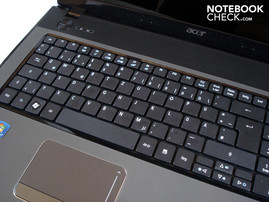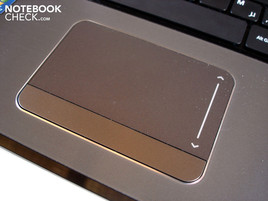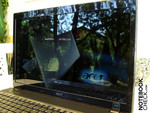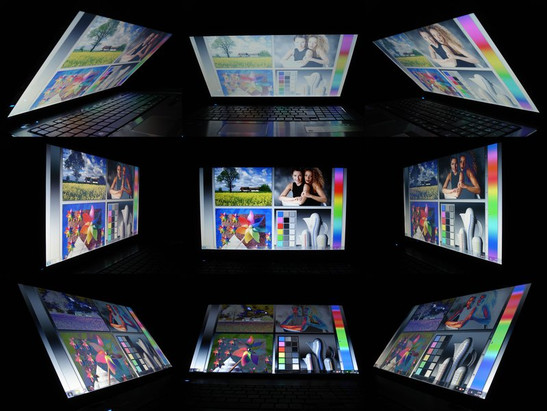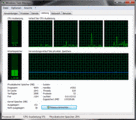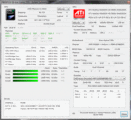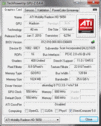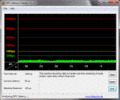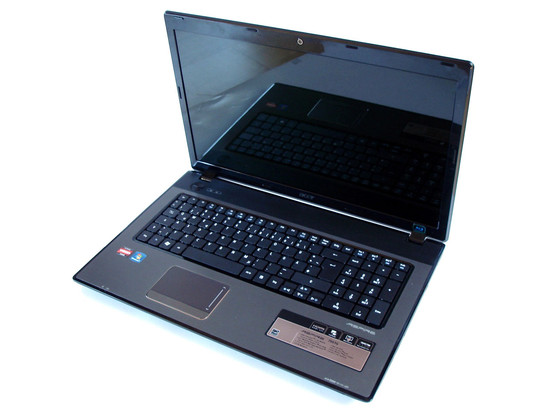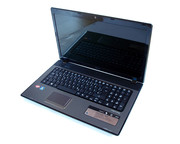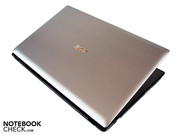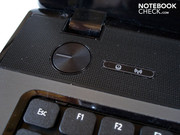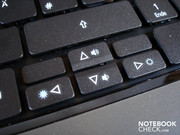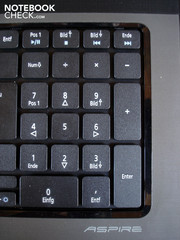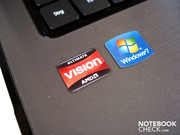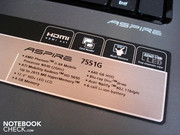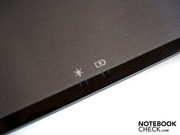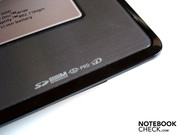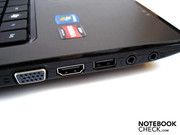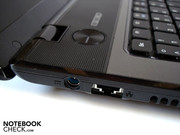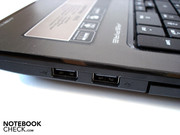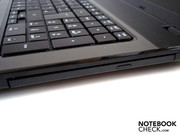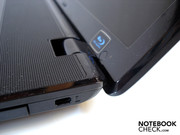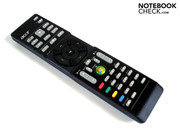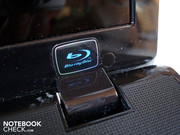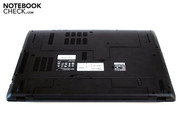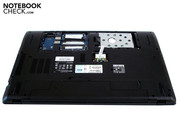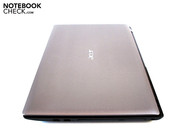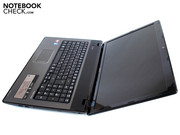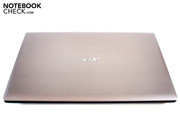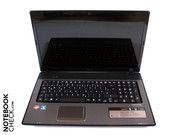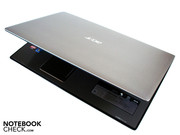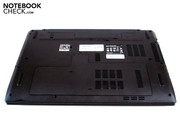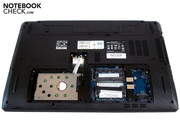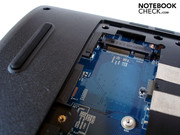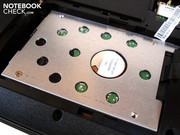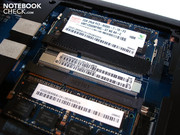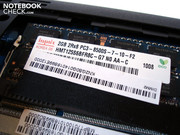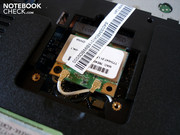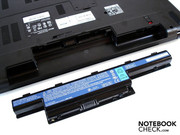Review Acer Aspire 7551G Notebook
Acer sticks to its line and again releases numerous models of the new Aspire 7551G series. We picked out the four most important alternatives to start with in order to shed a bit of light on the range of products.
It starts with the Aspire 7751G-N834G32Mn, which already goes over the counter for around 650 euro. The buyer gets a triple-core processor from AMD (Phenom II X3 N830, 3x 2.10 GHz), a 320 GB sized hard disk and a DVD burner. An ATI Mobility Radeon HD 5470 does its job as the graphic card, which is only suitable for games to an extent because of its relatively weak performance. The Aspire 7551G-N934G32Mn for about 730 euro bids significantly more graphic power, as it is equipped with a Mobility Radeon HD 5650 and a Phenom II X4 N930 quad-core processor (4x 2.00 GHz).
Acer also has a fitting bundle up its sleeve for entertainment fans. Thus, the Aspire 7551G-P524G64Bn can't only serve with a Mobility Radeon HD 5650 and a large 640 GB hard disk, but also with a BluRay drive for around 760 euro. In this case, Acer has opted for a Turion II P520 dual-core (2x 2.00 GHz). We've reviewed the Aspire 7551G-N934G64Bn, which unites all benefits of both aforementioned models, and should appeal to both gaming fans as well as movie lovers, is the cream of the crop. It's equipped with a Phenom II X4 N930, a Mobility Radeon HD 5650, a HDD with a capacity of 640 GB and a BluRay drive. Price: around 830 euro.
Apart from that, all models have a 17.3 inch display in a 16:9 format and a resolution of 1600x900 pixels. Every DDR3 RAM has a capacity of four GB. Not surprising - Windows 7 Home Premium 64 bit is used as the operating system.
Case
In regards to the case, the Aspire 7551G basically correlates to its 15 inch brother, Aspire 5551G and thus inherits almost all advantages and drawbacks.
Especially the design would be named on the pro side. The case not least makes a fresh impression due to its silver display lid with a grippy texture. Another bonus point is the pleasant wrist-rest that reminds of brushed aluminum in haptics, which gives the Aspire 7551G a certain amount of quality. The notebook isn't exactly handy or made for mobility with its 17 inch size, but due to its weight of 2.9 kg, the Aspire 7551G can still be carried around adequately anyway. Above that the notebook doesn't look bulky with a height of only 34 mm.
Now to the negative aspects. Thus, the stability is not at all well. The quite wobbly display lid can, for example, be bent and pressed alarmingly intense. Furthermore, the wrist-rest yields slightly towards the center and the case even emits an extreme and cheap sounding creaking noise under higher pressure. The workmanship of our test device isn't perfect either. The optical drive has very differently sized gaps. The extremely sensitive display bezel reveals itself as yet another weakness. In opposition to the other surfaces, it is made with a high-gloss finish and thus tends to scratch and grime quickly.
At least the hinges do a good job. We couldn't establish a lifting of the base unit at opening the lid. The maximum opening angle of 160° is well above average.
Configuration and Supplies
Connectivity
Acer presents itself as very conservative with connectivity. The user will look for an ExpressCard slot just as in vain as for a Firewire or eSATA port. The existing interfaces prove to be standard fare. Thus, the Aspire 7551G has a Kensington lock, RJ-45 gigabit LAN, three USB 2.0 ports (2 right, 1 left) and both an audio-in and audio-out. External monitors can be connected via VGA or HDMI, there's no display port. Acer has also integrated a 5-in-1 cardreader on the front, which is capable of SD, MMC, MS, MSPRO and XD formats.
In our opinion, the port arrangement is, expressed carefully, suboptimal. Reason: Acer has placed the majority of connection in the front area of both sides. If you connect many cables, you'll soon find your elbowroom limited and a mouse use could turn into a problem.
Software and Supplies
As (unfortunately) known from Asus, the Aspire 7551G's system is clogged by numerous software. These aren't usually any halfway sensible applications that give the user a particular advantage, but it's mostly so-called bloatware. A negative consequence of the bloated installation is a slower work speed and a longer system booting time. Because many programs also inhabit the notification area of the taskbar, the user is often faced with annoying pop ups. Thus, we can only recommend every buyer to devote himself to, admittedly, time-consuming, but ultimately also rewarding, deletion immediately after initializing the notebook.
Acer at least deserves praise for one software addition, though. The user receives a video software that can also render BluRay disks aside other formats with PowerDVD 9. If the Aspire 7551G weren't equipped with the according program, you'd have to buy expensive, additional software. Acer additionally includes a remote control, with which the Aspire 7551G can be controlled comfortably from the couch and movie enjoyment is really fun. Otherwise, the scope of supplies turns out rather scanty. The buyer will only find a short instruction manual, a warranty card and a quick start guide beside the 90 watt adapter. Acer has, as usual, not added any operating system DVDs.
Input Devices
Keyboard
On the whole, we quite liked the keyboard. The detached keys distinguish themselves by their well dimensioned size and acceptable pressure point. Merely the arrow keys have turned out extremely narrow on the vertical plane. The left shift key could also be a bit wider. Improvements could especially be made on the number pad in regards to stability. Because the optical drive is found under it, a noticeable yielding can already be established when moderate pressure is applied. The fairly loud and clattery key noise, which doesn't exactly relate a high-end impression, annoyed us most though.
Touchpad
One of the Aspire 7551G's absolute strengths is its top notch touchpad. The marginal lowering of it gives a sufficient amount of orientation. Above that, the rather smooth surface allows you to glide extremely pleasantly over the touchpad. The size of 90 x 50 mm is just as impressive as the always reliable multi-touch functions. The vertical scroll function works perfectly and Acer has provided it with a white line for better visibility Both touchpad key unite to one single bar and don't give reason for complaint in terms of sound or triggering responsiveness.
Display
The 17.3 inch display, with a screen diagonal of 43.45 cm, has enough room to consume all multimedia contents adequately. Above that, a resolution of 1600x900 pixel provides sufficient image area to, for example, work with two simultaneously opened windows. Movies also benefit from the 16:9 aspect ratio, as it reduces the typical black bar.
| |||||||||||||||||||||||||
Brightness Distribution: 62 %
Contrast: 229:1 (Black: 0.83 cd/m²)
So, basically excellent preconditions, if it weren't for the moderate display quality. You can work pleasantly with an average brightness of 170.5 cd/m2, but you'll soon find a higher luminosity missing in games or movies. Our test device's illumination also turned out surprisingly poor. Merely 126.2 cd/m2 in the darkest and 203.0 cd/m2 in the brightest spot result in a disappointing rate of 62%. At least the poor illumination is hardly noticed subjectively.
The black value places itself in the center field with 0.83 cd/m2. Dark areas don't really look deep black, but rather grayish. The contrast of 229:1 is also everything but overwhelming. However, the majority of current multimedia notebooks hardly do better in this exercise. Conclusively, the color representation is alright. The image appears significantly more brilliant than, for example, on a matt display.
The Aspire 7551G is, as you can imagine, unsuitable for outdoor use. Acer doesn't use an AR-coated display, which leads to intense reflections in according light incidence. The user is frequently faced with annoying reflections even indoors. If you spend a lot of time with office or internet activities, you should consider using an anti-reflection foil or buy a notebook with a matt display right away.
A short comment about the viewing angles, which prove to be very restricted on both the horizontal and vertical plane. Color representation and illumination are falsified quickly even at slightest deviations. This is at latest a problem when you want to watch a movie with several friends. At most only one person can see the display content fairly authentically.
Performance
It's taken a long time, but now at last: AMD celebrates its quad-core debut in the mobile division with the Phenom II X4. As Intel's current Core i-quad processors, the Phenom II X4 is also still manufactured in a 45nm process. Acer has opted for the N930 in the Aspire 7551G, which can serve with a clock rate of 2000 MHz. The power consumption can be described as acceptable with 35 watts. Comparable Core 2 Quad and Core i7 processors have a 10 watt higher consumption. The N930's cache has turned out extremely tight with two MBs. In comparison: The Core i7 range also has an L3 cache beside an L2 cache, which is set up significantly larger with six to eight MBs.
The midrange Mobility Radeon HD 5650 from ATI is used as the graphic card. The Radeon HD 5650 has 400 unified shaders (HD 5870: 800 unified shaders), 627 million transistors (HD 5870: 1040 million) and a 1024 MB sized DDR video memory. Unfortunately, the video memory is tethered to only 128 bits, which can turn into a bottleneck in higher resolutions. Acer doesn't make any experiments and uses the standard 550 MHz for the core and 800 MHz for the memory. The Radeon HD 5650 is state-of-the-art with DirectX11 support. The ATI can also keep the power consumption surprisingly low with 15-19 watts, not least due to the 40nm manufacturing process.
CPU Performance
The Phenom II X4 N930 doesn't only have to measure itself with the equally clocked Core 2 Quad Q9000 (Medion X9613), but also with the often used dual-corer, Core i5-430M (Acer Aspire 4820TG) in the application benchmarks. The Phenom II X4 N930 doesn't look particularly good in Cinebench R10's single-core rendering. It can't assert itself against the Q9000 (2643 points) or against the i5-430M (3446 points), whereas the latter can build up a considerable lead due to its turbo mode. The Q9000 takes over the lead in multi-core rendering with 8584 points. i5-430M (7849 points) and N930 (7432 points) follow at a good distance. The same picture is shown in 3DMark Vantage's CPU score: The N930, with 6731 points, follows both the i5-430M (7339 points) and the Q9000 (7817 points).
| PCMark Vantage Result | 4380 points | |
Help | ||
GPU Performance
The combination of Phenom II X4 N930 and Radeon HD 5650 can reap a good result of 20076 points in 3DMark 03. However, when the Radeon HD 5650 is supported by a Core i5-430M (Acer Aspire 4820TG), the performance increases by about 5% to 21056 points. The difference increases significantly in 3DMark 05. The Aspire 4820TG stands out by a remarkable 19% in comparison to the Aspire 7551G's with 13430 to 11218 points. The lead vanishes into thin air in 3DMark06: The Aspire (6719 points) and Aspire 7551G (6661 points) have again closed in on each other. The Aspire 7551G, with 3315 points, is also close behind the Aspire 4820TG (3415 points) in 3DMark Vantage, which correlates to a difference of 3%.
| 3DMark 03 Standard | 20076 points | |
| 3DMark 05 Standard | 11218 points | |
| 3DMark 06 Standard Score | 6661 points | |
| 3DMark Vantage P Result | 3315 points | |
Help | ||
HDD Performance
Acer equips the Aspire 7551G with a 640 GB sized hard disk from the quality manufacturer, Western Digital (WDC WD64000BEVT-22A0RT0). The average transfer rate of 65.5 MB/s is more than good for a HDD with 5400 rpm. The access rates of 17.8 ms are within the usual field. Acer has only set up one single partition (583 GB) on the hard disk, which certainly won't appeal to everyone
Performance Verdict
Seen on its own, the Phenom II X4 N930 no doubt bids a consistently good application performance. In comparison to the Intel competition, the N930's performance proves to be disappointing because the processor can't catch up to the quad-cores of the Core i7 and Core 2 Quad series, or to the dual-cores of the Core i5 range. Thus, AMD fans can take it, everyone else is better off with Intel, though.
Anno 1404
Anno 1404 proves to be a bit unsmooth in our benchmark resolution of 1280x1024, very high details and 4x AF with 27.9 fps. If you want to enjoy a fairly smooth game play in the native resolution of 1600x900, you should reduce the details to high. Anno 1404 still looks remarkable with that.
| Anno 1404 | |||
| Resolution | Settings | Value | |
| 1280x1024 | very high, 0AA, 4AF | 27.9 fps | |
| 1024x768 | low, 0AA, 0AF | 93.5 fps | |
Modern Warfare 2
Modern Warfare 2, currently in the news mainly because of the overpriced map bundles, can be played well even in high details and 4x AA with 35.8 fps (1366x768). The Aspire 4820TG continues the graphic benchmarks' trend and computes slightly faster with 37.9 fps (+6%).
| CoD Modern Warfare 2 | |||
| Resolution | Settings | Value | |
| 1366x768 | all on/high vsync off, high textures, 4xAA | 35.8 fps | |
| 1024x768 | all on/med vsync off, normal textures, 2xAA | 43.5 fps | |
Shift
Whilst you basically have to be content with medium details in the native resolution of 1600x900, Shift still runs fairly smooth in the resolution of 1366x768, even in high details and 4x AA (31.0 fps). For the first time, the Aspire 4820TG lags slightly behind with 29.9 fps.
| Need for Speed Shift | |||
| Resolution | Settings | Value | |
| 1366x768 | all on/high, 4xAA, triliniarAF | 31 fps | |
| 1024x768 | all on/med, 2xAA, triliniarAF | 38.3 fps | |
Bad Company 2
As already in Shift, the resolution of 1600x900 only allows a medium detail level. The Aspire 7551G is overtaxed in a resolution of 1366x768, high details and 4x AF with 29.6 fps. Because Bad Company 2 benefits noticeably from a quad-core processor, the Aspire 4820TG has to admit defeat with 28.1 fps.
| Battlefield: Bad Company 2 | |||
| Resolution | Settings | Value | |
| 1366x768 | high, HBAO on, 1xAA, 4xAF | 29.6 fps | |
| 1366x768 | medium, HBAO off, 1xAA, 1xAF | 44 fps | |
Risen
The resolution of 1366x768 even stutters along unplayable in high details and 4x AF. We determined a scanty 21.6 fps in our test. The Aspire 4820TG can't provide a smooth frame rate either, with 22.6 fps (+5%). Thus, you'll not be able to avoid medium details in the native resolution.
| Risen | |||
| Resolution | Settings | Value | |
| 1366x768 | all on/high, 4xAF | 21.6 fps | |
| 1024x768 | all on/med, 2xAF | 32.7 fps | |
Metro 2033
Metro 2033 forces even the best gaming notebooks to their knees with its exorbitant hardware demands. Therefore, it's no wonder that the shooter stutters extremely even in normal details and the DirectX 10 mode with 27.1 fps (1366x768). Metro 2033 runs even slower on the Aspire 4820TG with 26.4 fps.
| Metro 2033 | |||
| Resolution | Settings | Value | |
| 1360x768 | Normal DX10, AAA, 4xAF | 27.1 fps | |
| 800x600 | Low DX9, AAA, 4xAF | 57 fps | |
Dirt 2
DirectX 11's extended effects demand everything from the Radeon HD 5650 so that it's just enough for 28.5 fps in the resolution of 1366x768, high details and 2x AF. The Aspire 4820TG is noticeably inferior with 24.9 fps. Reason: Beside Anno 1404, Bad Company 2 and Shift, Dirt 2 counts to the tracks that can benefit from four CPU cores.
| Colin McRae: DIRT 2 | |||
| Resolution | Settings | Value | |
| 1360x768 | High Preset, 2xAA | 28.5 fps | |
| 1024x768 | Medium Preset, 0xAA | 61.3 fps | |
Crysis
Finally, the Aspire 7551G also has to prove itself in the demanding track, Crysis. As usual for midrange graphic cards, the Radeon HD 5650 is too weak for high details, no matter which resolution is used (29.2 fps in 1024x768). At least it's enough for a smooth frame rate in moderate resolutions with medium details (42.8 fps in 1024x768).
| Crysis - GPU Benchmark | |||
| Resolution | Settings | Value | |
| 1024x768 | High | 29.2 fps | |
| 1024x768 | Medium, 0xAA, 0xAF | 42.8 fps | |
Gaming Performance Verdict
The Phenom II X4 N930 supplies a better performance in practical gaming than it was the case in the synthetic benchmarks. If a game can benefit from a maximum of two CPU cores, it is on about the same level as Intel's popular Core i5-430M. On the other hand, the N930 can often surpass its Intel opponents in games that are already optimized for four cores. The price also speaks for the Phenom II X4. Whilst the quad-cores from Intel's Core i7 range aren't often found in gaming suitable multimedia notebooks for less than 900 euro, the Phenom II X4 processors score with a very fair value for money ratio.
Overall, the combination of Phenom II X4 N930 and Radeon HD 5650 supply a good gaming performance. If you waive on quality enhancements (AA & AF) when required, the Aspire 7551G is strong enough to present a majority of currently available games in medium to high details.
| low | med. | high | ultra | |
|---|---|---|---|---|
| Crysis - GPU Benchmark (2007) | 42.8 | 29.2 | ||
| Crysis - CPU Benchmark (2007) | 45.1 | 24.3 | ||
| Anno 1404 (2009) | 93.5 | 27.9 | ||
| Colin McRae: DIRT 2 (2009) | 61.3 | 28.5 | ||
| Need for Speed Shift (2009) | 38.3 | 31 | ||
| Risen (2009) | 32.7 | 21.6 | ||
| CoD Modern Warfare 2 (2009) | 43.5 | 35.8 | ||
| Battlefield: Bad Company 2 (2010) | 44 | 29.6 | ||
| Metro 2033 (2010) | 57 | 27.1 |
Emissions
System Noise
The Aspire 7551G barely gives reason for reproach in regards to noise development. When the notebook is only put under low load, the case fan is merely slightly audible. The fan occasionally turns up to a higher pitch for a short time, but it didn't annoy us subjectively. If a DVD or CD is inserted in the drive, an audible noise is noticed when data is accessed, which is common for most notebooks. What's more, the optical drive emits a slight ratter noise when it renders BluRay disks, but which is usually drowned out by a movie's soundscape, though.
In 3D applications and games, the noise emissions fluctuate between an audible to very audible level. However, the user won't hear much of that in louder games, like first person shooters. The soundscape surprisingly doesn't increase under full load. Many notebooks achieve far beyond 40 dB(A). Furthermore, the Aspire 7551G has to be given credit for a quite pleasant fan noise, no matter under how much load the notebook is ultimately put.
Noise Level
| Idle |
| 29.6 / 32.3 / 36.4 dB(A) |
| HDD |
| 32.7 dB(A) |
| DVD |
| 35.6 / dB(A) |
| Load |
| 39.5 / 39.5 dB(A) |
 | ||
30 dB silent 40 dB(A) audible 50 dB(A) loud |
||
min: | ||
Temperature
Whilst the noise emissions are alright, the temperature development need more critique. The upper side is still fairly cool with a maximum of 32.7°C and the wrist-rest remains under the 30°C mark. But the bottom already heats up noticeably with a maximum of 36.1°C. The bottom's temperature even heats up to 46.7°C under load. If the notebook is used on the lap with the according capacity, it can quickly get unpleasant. We also found the wrist-rest unpleasant, which reaches up to 39.8°C under load. Furthermore, a temperature of 41.0°C is measured in the WASD key area.
Let's take a peek inside. Both the processor (~53°C) and the graphic card (~48°C) prove to be not exactly cool. The components temperatures increase moderately by about 20°C under full load (Prime+Furmark). Thus, the Radeon HD 5650 heats up to 69°C, whereas the Phenom II X4 N930 can record a maximum temperature of 72°C for itself - both acceptable rates. The problem about that: As soon as the processor is put under full load, it immediately clocks itself down from 2000 to 800 MHz. A CPU throttling occurs. But because such a load situation will never turn up in games, you don't have to fear a processor throttling. At least performance breakdowns don't turn up in our test device.
(±) The maximum temperature on the upper side is 41.3 °C / 106 F, compared to the average of 36.9 °C / 98 F, ranging from 21.1 to 71 °C for the class Multimedia.
(-) The bottom heats up to a maximum of 46.7 °C / 116 F, compared to the average of 39.2 °C / 103 F
(+) In idle usage, the average temperature for the upper side is 30.8 °C / 87 F, compared to the device average of 31.3 °C / 88 F.
(±) The palmrests and touchpad can get very hot to the touch with a maximum of 39.8 °C / 103.6 F.
(-) The average temperature of the palmrest area of similar devices was 28.8 °C / 83.8 F (-11 °C / -19.8 F).
Loudspeakers
Acer has treated the Aspire 7551G to two loudspeakers that are hidden behind a hairline grid above the keyboard. The stereo loudspeaker's sound qualities are limited. The maximum volume is impressive, but the notebook-typical deficiencies come to light. Thus, it basically lacks precision, dynamics and volume, the sound makes a generally hollow and dull impression. Because a subwoofer has been omitted, the bass is also very weak. When the speakers are put under too much load, certain pitches can additionally fray. If possible, an external sound system should be used.
Battery Life
The weak six cell battery (48 Wh) and the lack of a switching function between an integrated and dedicated graphic card (switchable graphics) already in infer it: The Aspire 7551G's battery life is very poor and in no way appropriate for a multimedia notebook.
The notebook said good bye after not even 76 minutes with maximum brightness and medium energy savings options while it was rendering a BluRay disk. That is definitely not long enough for an average length movie. The runtime is also relatively low in internet surfing via the integrated WLAN. The Aspire 7551G had to go back to the mains after almost two hours.
In order to determine the maximum possible runtime, we ran BatteryEater's Reader's test with minimum brightness and maximum energy savings options. Result: Two hours and 58 minutes. The minimum (BatteryEater's Classic test with maximum brightness and disabled energy saving options) places itself in the field of a typical gaming notebook (e.g. Medion Akoya X7811).
The energy requirement proves to be acceptable with 13.6 watts in idle mode and 54.9 - 89.0 watts under load. Similarly equipped 17 inch notebooks, like the Aspire 7745G also from Acer, consume about the same amount.
| Off / Standby | |
| Idle | |
| Load |
|
Key:
min: | |
Verdict
The Aspire 7551G-N934G64Bn reveals a few strengths, but also numerous striking weaknesses. Especially the very good value for money ratio has to be mentioned on the positive side. The buyer doesn't only get a BluRay drive and a 640 GB sized hard disk, but a DirectX11 capable midrange graphic card and a quad-core processor at the same time, for a fair price of about 830 euro. The built-in Phenom II X4 N930 can't keep up with the current competition from Intel in (optimized) applications, but the distance shrinks in games and the Aspire 7551G can score with a good performance. The reliable touchpad and the chic case including its mostly insensitive silver surfaces are unique features.
On the other hand, the restricted connectivity, the high temperature development under load and the poor battery life are on the negative side. The workmanship isn't perfect either. The varying gaps of the optical drive and a creaking wrist-rest shouldn't actually be found. The biggest annoyance is, however, once again the moderate display quality. No matter if brightness, illumination, contrast or viewing angles - almost all aspects prove to be everything but perfect.
Consequently, it's not quite enough for a rating above 80%. The Aspire 7551G-N934G64Bn has earned itself a "Good" anyway.







